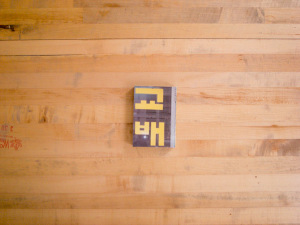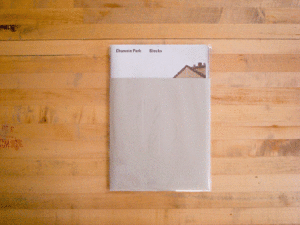As usual, I returned from Seoul with a suitcase full of books. Because of my limited time for browsing for books during my brief trips, I generally err on the side of caution and buy a book if I see some detail that I think bodes well: a design flourish, a single image that catches my eye, a weight or density. This generally works well for me. Sometimes it doesn’t.
Taeyoung Kang’s In Between is full of promise. The simple and distinctive Aprilsnow Press’ cover design with a photo tipped into the bright red linen is an opening salvo. It calls out from the book shelf. On a cursory glance through, there are numerous wonderfully composed and engaging photographs.
A WB Yeats quote from “Sailing to Byzantium” sets the book’s tone: “Whatever is begotten, born and dies.” The first several pictures take this cue and run with it. The first picture is two empty shell sitting beside several small plants in loose soil; the caption tells us this is in a cemetery. It is followed by a pair of landscapes of the tombs in Gyung-ju; in the first, two boys wearing white back to back stepping away from one another as though dueling; in the second, picture there is only one boy, crouching. The next picture is a boy playing in a ruin; he appears to levitate off the ground, his head poking into a window in the ruin. From this strange and slightly unsettling opening, the book begins to wander.
The wandering is literal and figurative. We are brought to France, back to Korea, then on to Mauritius, Switzerland, Hong Kong, the US, Turkey, Jordan, Italy, Germany, Syria and England. All are revisited throughout the book. It is a whirlwind world tour of the everyday: street scenes, still life vignettes, grand landscapes and portraits.
Though we may travel the world, we are not among a family of man. This is not some grand statement of unity. Instead we are in a space of “between-ness”. In our shifting location we are never “here”; we are always moving between. The photographs hover between light and dark: a young girl on the edge of a pool of light steps out into the dark surround; a boy hides behind a lamp post’s silhouette before a luminous background of dirt; a man directly under a light in a restaurant covers his face; a young woman at a bar sits in a pool of light looking out at the crowd surrounding her recede into darkness. We are often divided from the subjects we view: they are half hidden by other objects in the scene; they are partly erased by reflections in glass; or they are covered by shadow. Or the we catch a moment between moments: a pair of people in mid-step, their weight neither still on the top step or yet on the bottom step; a man leaning over to lift a brazier of coals, his hand pulling on its handle but not yet taking its weight.
This is a book that I wanted to like it and expected to. There are many lovely images and as an object the book is nicely designed, printed and put together. It looks great on my book shelf. Any number of the photographs would look wonderful framed on the wall. However, the wandering is too great. We cover too much territory. A third of the images could have been left on the editing table. Flipping through the book too many images pull me from the rhythm and disrupt the flow. I can’t find reason for transitions between images; I’m not sure what I am meant to come to understand through reading this book.
In Between
Taeyoung Kang
with text by Kay Jun
Edited and Designed by Kay Jun, Jeong Jae-wan
Proofread by Kang Young-gyu
Translated by Angelina Gieun Lee
Printed by Munsung Printing
Published by Aprilsnow Press
First edition January 2013

